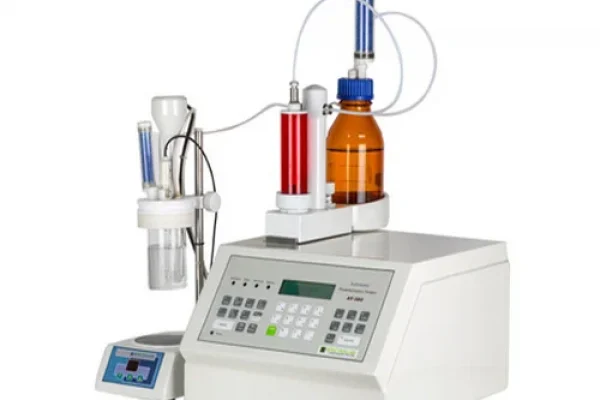Project Report For Titrators
Introduction
Project Report For Titrators is as follows.
Titration is a chemical analysis process that identifies the quantity of an ingredient in a sample by adding a precisely known amount of another substance to the measured sample, with which the desired constituent interacts in a particular, known proportion. The method is typically carried out by progressively adding a standard solution (i.e., a known concentration) of titrating reagent, or titrant, from a burette, which is essentially a long, graduated measurement tube with a stopcock and a delivery tube at one end. The addition is terminated when the equivalence point is reached.
An absolutely comparable amount of titrant has been applied to the sample at the equivalence point of a titration. The end point is the experimental point at which the conclusion of the reaction is indicated by some signal. This signal might be a change in the colour of an indicator or a change in an electrical characteristic observed during the titration. The titration error is the difference between the end point and the equivalence point, which is kept as little as possible by selecting an appropriate end-point signal and method for detecting it.
an Appropriate visual colour indication that signals the end point at or around the equivalence point may be found. Acid-base titrations, precipitation titrations, complex-formation titrations, and oxidation-reduction (redox) titrations are examples of such titrations, which are categorised based on the type of the chemical reaction that occurs between the sample and titrant. The indicator in acid-base titration (the titration of an acid with a base or vice versa) is a chemical that can exist in two forms, acid and basic, which differ in colour. Litmus, for example, is blue in alkaline solution but red in acid solution.

Uses of Titrators in Industries
Titration is a quantitative chemical analysis procedure used in laboratories. When an indicator is present, it is utilised to determine the unknown concentration of an element using the known concentration of a solution. The titrant is the solution used during titration with a known precise concentration, and the material whose volume is to be determined is said to be titrated. A calibrated concentration of titrant is added to an unknown concentration of analyte to determine the endpoint of titration for analysis, and when the endpoint is reached, the moles of titrant and analyte are equal. The many forms of titration are as follows:
- Titration of acid and base :- When an acidic or basic titrant interacts with a base or acid analyte, an acid-base titration occurs. It is a method of estimating the concentration of an acid or base by precisely neutralising it with a known concentration standard solution of either acid or base.
- Titration of redox :- An oxidation-reduction process is also known as redox titration. Electrons are moved between reactive ions in aqueous solutions in this sort of titration, triggering a chemical reaction. Because the reaction is a redox reaction, the titration between oxalic acid solution and acidified KMnO4 solution is a redox titration. The redox indicator is the indicator used in redox titration.
- Titration of precipitation :- Precipitation Titration is a type of titration based on the production of an insoluble precipitate when two reacting chemicals come into close contact. When silver nitrate is combined with ammonium thiocyanate or sodium chloride, it reacts and generates a white precipitate of silver chloride or silver thiocyanate.
- Titration using complexometrics :- The interaction of the titrant and analyte serves as the foundation for complexometric titrations. A metal-ligand complexation mechanism is used in complexometric titrations. The chelating substance EDTA (Ethylenediaminetetraacetic acid) is widely employed in analytical chemistry for complexometric titrations.
Get Completely Custom Bankable Project Report
Market Potential for Titrators
The market for titration devices is anticipated to grow at a CAGR of 8% from 2022 to 2027.
The market for automatic potentiometric titrators is expanding as end-use industries demand more precise and quick titrations. The growing concern in the pharmaceutical industries about upholding quality standards is another factor anticipated to fuel the market for potentiometric titrators.
Titration is a quantitative chemical analysis method for calculating a dissolved substance’s concentration. By measuring the potential difference between the indicator electrode and the reference electrode when the current passed through the solution only maintains thermodynamic equilibrium, potentiometric titration can be used to determine the concentration of a chemical component in a solution.
During the projected period, the automated titration sector is likely to contribute significantly to the growth of the studied market. It is mostly owing to the increasing demand for an automated lab titration procedure that favours the necessary functionality while minimising human error. Furthermore, several research papers demonstrating the efficiency of automated titration procedures over manual titration techniques increased market demand for automated titration equipment.

